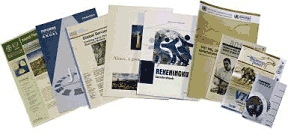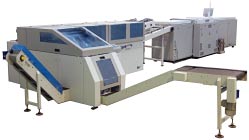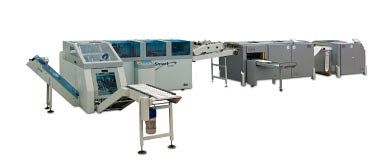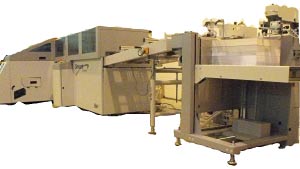 |
|||||
|
|||||
| December
2008
Nine critical steps when selecting a digital print finishing system 1/
What type and quality of finished output is needed ?
The IBIS Smart-binder system was developed specifically for
producing books/ booklets from digitally printed sheets . Smart-binder
models SB-1 or SB-2 produce only saddle wire-stitched booklets. The
SB- 3 provides the choice of traditional saddle-stitched or saddle cold-glued
books (cold gluing is becoming the preferred method due to increased
book strength, better lay-flat and easier operation). The SB-4 can also
produce ‘perfect-bound’ books up to 60mm thick, in addition
to thinner saddle-bound booklets. 2/ Will the number of pages in the book be changed ‘on-the-run’? If the system is to be used for short job runs, or ‘personalised’ books then it must be able to produce varying book thicknesses without having to stop for adjustments to be made. The Smart-binder range is unique in that it can produce varying thickness books ‘on-the-run’. 3/
How many different format sizes are needed?
4/
Are there any book security or integrity issues? Security
and page integrity can be vital, for example when producing exam papers
or insurance documents. This may influence your choice of system towards
an in-line or near-line system where the continuous web offers a higher
degree of document integrity than cut sheets. Special extra sheet-tracking
(bar code reading or cameras) may be needed. Gluing may be preferred
instead of wire-stitching to ensure sheets cannot be easily removed
from the finished document. 5/
Are separately-fed covers, or ‘insert’ sheets, needed?
The option for additional cover or insert feeders needs to be considered.
The Smart-binder can be fitted with additional feeders, if required. 6/
Printer operating speed ? If finishing in-line then
the printer speed will dictate the minimum number of pages in the book
and whether any additional modules are needed (such as the optional
F-100 folder for printer speeds higher than approx. 300 sheets/min)
7/
Is in-line finishing the right option ? Another option for CF systems
is to use a “near line” finishing system, where the printing
process is roll to roll. Off-line 8/
What paper weights will being used? The Smart-binder
is best suited to weights between 60 and 110 gms (18 and 24-Lb. Bond).
For lighter paper weights the use of the F100 folder (to pre-fold the
sheets before entering the Smart-binder) and the anti static option
ASS-100, are needed. Pre-folding requires 8-pages per sheet (instead
of 4 ) and requires an extra glue system (in the folder) if using the
ISG cold-glue binding. 9/ Do you need any additional options such as cut outs, perforations, loop stitching, hole punching, stacking ? The Smart-binder option list is extensive; allowing the end-user to produce many different booklet types. Examples include different types of binding (cold glue, wire stitch) the use of cut-out ‘windows’ in the cover, dynamic sheet-perforation for page tear- out, hole punching or drilling, book stacking and pile banding etc. For more detailed information
see our Smart-binder Application Guide booklet, available to download
at: www.ibis-bindery.com/downloads.htm yours sincerely John Cracknell Managing Director IBIS Bindery Systems |
|||||
|
Sales General : |
||||
| Don Piontek
|
CP Bourg Inc. Chuck Taylor |
John Cracknell tel +44 (0) 1494 561950 |
|||
 This
will determine how flexible you need the system to be, and to whether
additional sheet folders or turners are needed. If the system needs
to be changed frequently to produce varying book formats, then this
may mean an off-line finishing system is preferred.
This
will determine how flexible you need the system to be, and to whether
additional sheet folders or turners are needed. If the system needs
to be changed frequently to produce varying book formats, then this
may mean an off-line finishing system is preferred. For finishing with high-speed (continuous forms) digital printers,
then it is often preferred to link the Smart-binder in-line to the
printer and web cutter. In-line finishing usually provides the lowest
cost and most efficient operation by reducing manual intervention
and minimising time from printing to book output.
For finishing with high-speed (continuous forms) digital printers,
then it is often preferred to link the Smart-binder in-line to the
printer and web cutter. In-line finishing usually provides the lowest
cost and most efficient operation by reducing manual intervention
and minimising time from printing to book output. The
printed roll is then unwound through a web cutter directly into the
Smart-binder. This has the advantage of being able to optimise running
speeds independently for printing and finishing, but greatly extends
the time between printing and book output. It also breaks up book
sequence which may be important for long-run personalised document
production.
The
printed roll is then unwound through a web cutter directly into the
Smart-binder. This has the advantage of being able to optimise running
speeds independently for printing and finishing, but greatly extends
the time between printing and book output. It also breaks up book
sequence which may be important for long-run personalised document
production. finishing
means producing piles of printed sheets which are then loaded into
a sheet pile feeder connected to the finishing machine. This is ideal
for finishing sheets produced from multiple printers, or when format
sizes are changing frequently, due to the extra system flexibility.
Pile feeding also results in a loss of book print sequence unless
the piles are turned over in between stacking and re-feeding.
finishing
means producing piles of printed sheets which are then loaded into
a sheet pile feeder connected to the finishing machine. This is ideal
for finishing sheets produced from multiple printers, or when format
sizes are changing frequently, due to the extra system flexibility.
Pile feeding also results in a loss of book print sequence unless
the piles are turned over in between stacking and re-feeding.